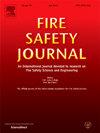Strategies for fire-fighting in underventilated compartments: Reducing the likelihood and severity of a potential backdraught
IF 3.4
3区 工程技术
Q2 ENGINEERING, CIVIL
引用次数: 0
Abstract
Fires in underventilated compartments remain an unresolved problem for fire brigades. While some brigades have specific guidance in place regarding procedures for approaching and fighting such fires, this guidance is, for the most part, based on anecdotal evidence, having been instigated following historical incidents involving fire-fighter injuries or fatalities.
As fire-fighters open a door or window to an under-ventilated compartment fire, there is a risk of a sudden fire development that may come in the form of a rapid flare up or backdraught. A programme of reduced scale fire experiments was designed to obtain deeper insight into this phenomenon. The results of these experiments are presented showing the conditions under which changes in the ventilation conditions of an underventilated compartment were beneficial for firefighting activities and under which conditions this was detrimental.
This paper provides further scientific understanding of the fire dynamics in underventilated compartments when changes in ventilation conditions occur. The use of ventilation tactics, preceded by strict safety precautions and comprehensive tactical considerations, appears to be a practical solution that reduces the likelihood and severity of a potential backdraught. The results presented could be used to develop simple guidance, which may be used in fire brigade practice, to decide when and how to intervene in this kind of fires.
在通风不良的车厢里灭火的策略:减少潜在回风的可能性和严重性
在通风不良的隔间发生火灾仍然是消防队的一个未解决的问题。虽然有些旅对接近和扑灭这类火灾的程序有具体的指导,但这些指导在很大程度上是根据轶事证据,是在历史上发生涉及消防员受伤或死亡的事件后制定的。当消防队员打开一扇门或一扇窗来应对通风不良的隔间火灾时,可能会有突然发生火灾的风险,可能会以快速燃烧或回风的形式出现。为了更深入地了解这一现象,设计了一个缩小规模的火灾实验方案。这些实验的结果显示了在通风不足的隔间的通风条件的变化有利于消防活动的条件下,在哪些条件下这是有害的。本文为进一步科学地认识通风条件变化时不通风舱室的火灾动力学提供了依据。在严格的安全预防措施和全面的战术考虑之前,使用通风战术似乎是一种实际的解决方案,可以减少潜在回风的可能性和严重性。所得结果可用于制定简单的指导方针,可用于消防队实践,以决定何时以及如何干预此类火灾。
本文章由计算机程序翻译,如有差异,请以英文原文为准。
求助全文
约1分钟内获得全文
求助全文
来源期刊

Fire Safety Journal
工程技术-材料科学:综合
CiteScore
5.70
自引率
9.70%
发文量
153
审稿时长
60 days
期刊介绍:
Fire Safety Journal is the leading publication dealing with all aspects of fire safety engineering. Its scope is purposefully wide, as it is deemed important to encourage papers from all sources within this multidisciplinary subject, thus providing a forum for its further development as a distinct engineering discipline. This is an essential step towards gaining a status equal to that enjoyed by the other engineering disciplines.
 求助内容:
求助内容: 应助结果提醒方式:
应助结果提醒方式:


